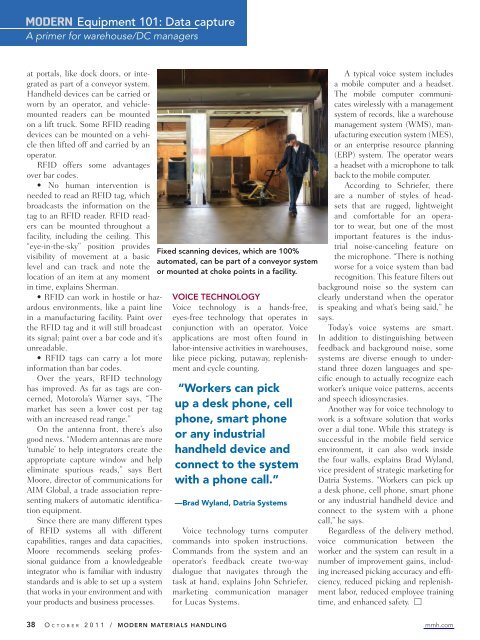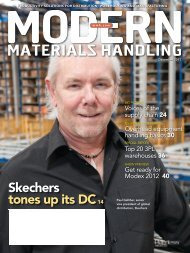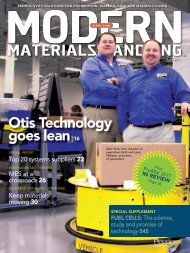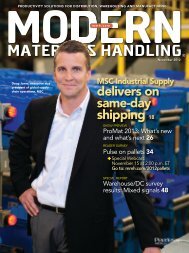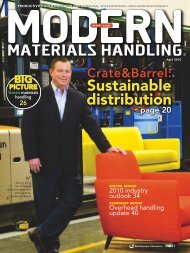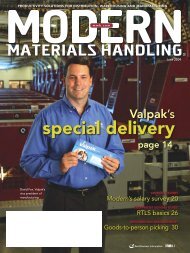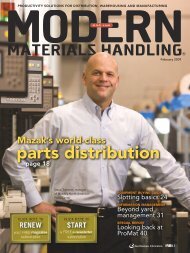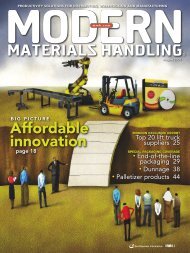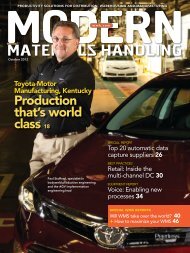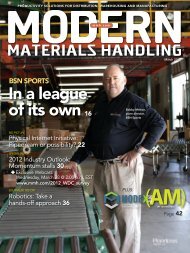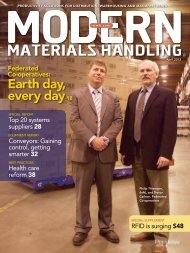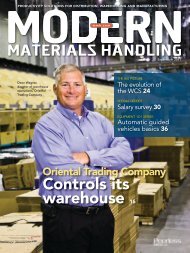You also want an ePaper? Increase the reach of your titles
YUMPU automatically turns print PDFs into web optimized ePapers that Google loves.
modern Equipment 101: Data captureA primer for warehouse/DC managersat portals, like dock doors, or integratedas part of a conveyor system.Handheld devices can be carried orworn by an operator, and vehiclemountedreaders can be mountedon a lift truck. Some RFID readingdevices can be mounted on a vehiclethen lifted off and carried by anoperator.RFID offers some advantagesover bar codes.• No human intervention isneeded to read an RFID tag, whichbroadcasts the information on thetag to an RFID reader. RFID readerscan be mounted throughout afacility, including the ceiling. This“eye-in-the-sky” position providesvisibility of movement at a basiclevel and can track and note thelocation of an item at any momentin time, explains Sherman.• RFID can work in hostile or hazardousenvironments, like a paint linein a manufacturing facility. Paint overthe RFID tag and it will still broadcastits signal; paint over a bar code and it’sunreadable.• RFID tags can carry a lot moreinformation than bar codes.Over the years, RFID technologyhas improved. As far as tags are concerned,Motorola’s Warner says, “Themarket has seen a lower cost per tagwith an increased read range.”On the antenna front, there’s alsogood news. “<strong>Modern</strong> antennas are more‘tunable’ to help integrators create theappropriate capture window and helpeliminate spurious reads,” says BertMoore, director of communications forAIM Global, a trade association representingmakers of automatic identificationequipment.Since there are many different typesof RFID systems all with differentcapabilities, ranges and data capacities,Moore recommends seeking professionalguidance from a knowledgeableintegrator who is familiar with industrystandards and is able to set up a systemthat works in your environment and withyour products and business processes.Fixed scanning devices, which are 100%automated, can be part of a conveyor systemor mounted at choke points in a facility.VOICE TECHNOLOGYVoice technology is a hands-free,eyes-free technology that operates inconjunction with an operator. Voiceapplications are most often found inlabor-intensive activities in warehouses,like piece picking, putaway, replenishmentand cycle counting.“Workers can pickup a desk phone, cellphone, smart phoneor any industrialhandheld device andconnect to the systemwith a phone call.”—Brad Wyland, Datria SystemsVoice technology turns computercommands into spoken instructions.Commands from the system and anoperator’s feedback create two-waydialogue that navigates through thetask at hand, explains John Schriefer,marketing communication managerfor Lucas Systems.A typical voice system includesa mobile computer and a headset.The mobile computer communicateswirelessly with a managementsystem of records, like a warehousemanagement system (WMS), manufacturingexecution system (MES),or an enterprise resource planning(ERP) system. The operator wearsa headset with a microphone to talkback to the mobile computer.According to Schriefer, thereare a number of styles of headsetsthat are rugged, lightweightand comfortable for an operatorto wear, but one of the mostimportant features is the industrialnoise-canceling feature onthe microphone. “There is nothingworse for a voice system than badrecognition. This feature filters outbackground noise so the system canclearly understand when the operatoris speaking and what’s being said,” hesays.Today’s voice systems are smart.In addition to distinguishing betweenfeedback and background noise, somesystems are diverse enough to understandthree dozen languages and specificenough to actually recognize eachworker’s unique voice patterns, accentsand speech idiosyncrasies.Another way for voice technology towork is a software solution that worksover a dial tone. While this strategy issuccessful in the mobile field serviceenvironment, it can also work insidethe four walls, explains Brad Wyland,vice president of strategic marketing forDatria Systems. “Workers can pick upa desk phone, cell phone, smart phoneor any industrial handheld device andconnect to the system with a phonecall,” he says.Regardless of the delivery method,voice communication between theworker and the system can result in anumber of improvement gains, includingincreased picking accuracy and efficiency,reduced picking and replenishmentlabor, reduced employee trainingtime, and enhanced safety. M38 O c t o b e r 2 0 1 1 / <strong>Modern</strong> <strong>Materials</strong> <strong>Handling</strong> mmh.com


